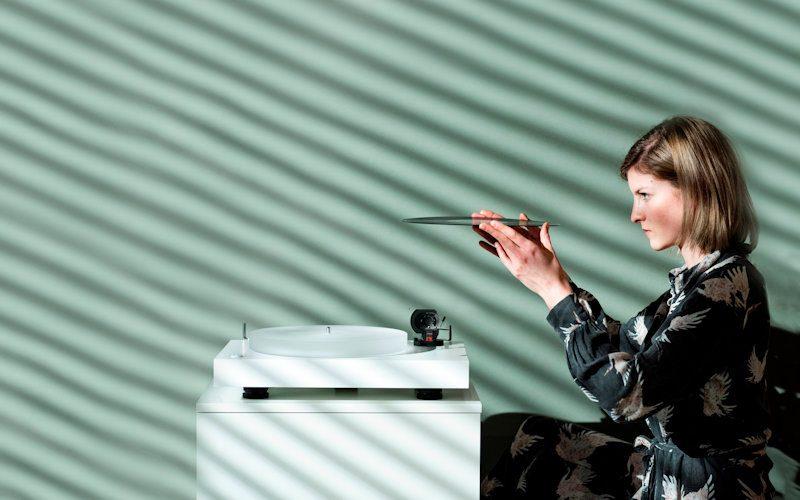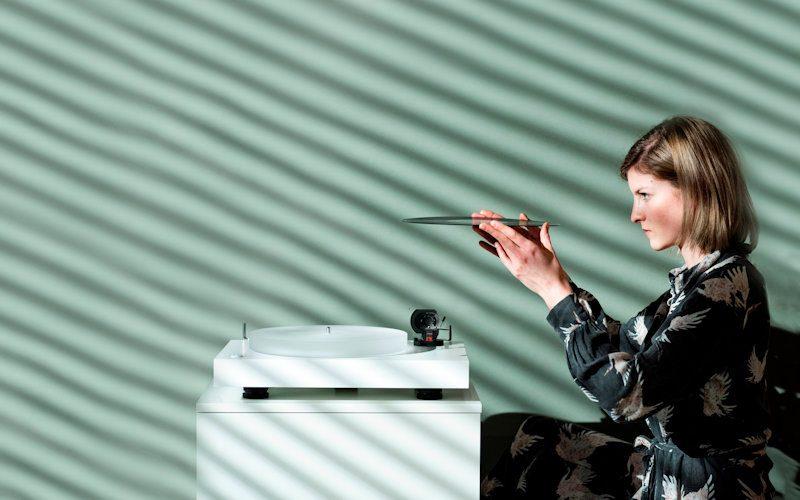

Andrew Robinson began his career as an art director in entertainment advertising in 2003, after graduating from Art Center College of Design. In 2006, he became a creative director at Crew Creative Advertising, and oversaw the agency's Television Division, where he worked for clients such as TNT, TBS, History, FX, and Bravo to name a few. He now has one of the most popular AV-related channels on YouTube.
Odd, this being a home theater publication and all, that I would be A) reviewing yet another analog turntable and B) find myself more excited about it in comparison to the multitudes of AV receivers and digital audio components that often grace my living room. To me, the allure of vinyl playback has nothing to do with the format sounding "better" when compared to digital; it has to do with the act of listening to physical records. Listening to records is usually always an active experience for me, whereby I make time to sit down and enjoy what it is the recording artist is trying to communicate. By contrast, with digital music playback, I will often just "put it on" and then do a host of other things simultaneously. Nothing wrong with the latter, just that I would argue that I'm not actually listening all that closely--let alone enjoying the experience, per se.
The turntable under review this time around is the new X2 from Pro-Ject, a $1,299, moving magnet platter-spinner designed to give enthusiasts a true taste of high-end analog playback, at a not too out-of-reach price. The X2 sits above the $899 X1 in the X Line, but well below the almost $5,000 asking price of the Xtension 12. Honestly, roughly $1,300 isn't too shabby for a product that is built by hand in Europe.
You'd be forgiven if at first glance you mistook the X2 for the X1, as the two do appear similar. Look closer, however, and you'll notice a few key differences, starting with the X2's chassis. Made from a single chunk of MDF, the X2's thicker, denser, and all-around beefier plinth is the most noticeable difference between it and the less-expensive X1. The X2's chassis contributes to an overall unit weight of 22 pounds--an increase of seven pounds over the X1. Of course, a denser, heavier plinth aids in the table's overall sound by lowering resonances. The X2's MDF chassis can be had in four decidedly delicious finishes that include satin white, satin black, high-gloss black, and walnut. My review sample was clad in walnut and was absolutely stunning to behold.
The X2 is a belt-driven design, despite no belt being visible due to its placement below the thick, semi-transparent acrylic platter. Thankfully, the X2 has an electronically regulated motor with an equally handy electronic speed control, allowing users to easily switch between 33 and 45 rpm speeds without having to remove the platter. I am typically not a fan of having to perform speed changes via manually manipulating the belt, especially when that change requires me to remove the platter, so the presence of a speed box within the X2 is a welcomed feature for me.
The X2's tonearm is longer at nine inches as compared with the X1, though its construction is pretty much the same. What isn't the same, however, is the
included MM cartridge that comes as standard on the X2. In the U.S., the X2 ships by default with a Sumiko Moonstone cartridge, which has an à la carte retail price of roughly $299 USD. It should be noted, however, that other markets receive the X2 with a Pick it 2M Silver MM cartridge, manufactured by Ortofon for Pro-Ject exclusively, which has an à la carte retail price of roughly $222 USD (199 Euros).
Lastly, the X2 ships with all the required cables necessary to get you up and running in no time. The turntable doesn't feature a built-in phono stage, so the included Pro-Ject cables (which are very nice, by the way) do need to be connected either to your preamp's internal phono input, or to an outboard phono preamp.
For more details and specs on the X2 please visit Pro-Ject's website, specifically the X2 product page.
Performance
A turntable's sound is in the sum of its parts. This includes things like its cartridge, as well as the phono preamp to which the player is connected. Since my review unit was shipped with a Sumiko Moonstone cartridge and not the Pick it 2M Silver that the rest of the world receives, do keep in mind that my sonic impressions may not entirely match your own, if you don't live in the U.S. Also, I utilized three different phono stages with the X2 during my evaluation period, coming away with decidedly different opinions of the table's performance with each.
 Straight away, when connected to my Marantz NR1200 stereo receiver's internal phono preamp, the pairing proved completely uninspiring, lifeless, and soft. It would appear the Marantz lacks the necessary gain for the X2 and its Moonstone cartridge. Plugging the X2 directly into the phono input of the Technics SU-G700 integrated amp changed things dramatically and was in line with the performance I also achieved when connecting the X2 to the Technics using Pro-Ject's own Phono Box Ultra 500 phono preamp ($399).
Straight away, when connected to my Marantz NR1200 stereo receiver's internal phono preamp, the pairing proved completely uninspiring, lifeless, and soft. It would appear the Marantz lacks the necessary gain for the X2 and its Moonstone cartridge. Plugging the X2 directly into the phono input of the Technics SU-G700 integrated amp changed things dramatically and was in line with the performance I also achieved when connecting the X2 to the Technics using Pro-Ject's own Phono Box Ultra 500 phono preamp ($399).
Via these two combos, I found the X2's overall sound to be balanced and neutral. Most audio components have a sort of signature thing that they do, something for listeners to grab hold of and say, "A Ha!" I kept waiting for the X2 to present an A Ha moment to me, whether it be its dynamic prowess, bass retrieval, treble extension, or midrange liquidity, and yet, nothing like that ever materialized. This is actually a good thing, if somewhat frustrating at first. A component having a signature to its sound makes my job that much easier; instead I'm stuck trying to come up with a way to accurately describe the X2's complete lack of any real personality--apart from what exists in the grooves themselves.
 The X2's sound isn't forward; it has a wide and well-defined soundstage that is nicely appointed but not laser etched. Its soundstage is also one that extends beyond the speakers' boundaries, though it doesn't extend forward of the front baffles--ever. Focus, detail, and texture are all top-notch and very well balanced (unless of course the recording calls for something different). Dynamics are a bit on the soft or polite side, but they're still present and can be coaxed into being more bombastic with dash of volume. High frequencies are very smooth, free of sibilance and harshness at the extremes; likewise, bass is taut and weighty, but never bloated. The X2 on a whole is really a very well-balanced piece of kit, almost to the point of being maddening, for we often like our components to impart some sort coloration to what we're hearing, and the X2--at least in my tests--really goes out of its way to not do that.
The X2's sound isn't forward; it has a wide and well-defined soundstage that is nicely appointed but not laser etched. Its soundstage is also one that extends beyond the speakers' boundaries, though it doesn't extend forward of the front baffles--ever. Focus, detail, and texture are all top-notch and very well balanced (unless of course the recording calls for something different). Dynamics are a bit on the soft or polite side, but they're still present and can be coaxed into being more bombastic with dash of volume. High frequencies are very smooth, free of sibilance and harshness at the extremes; likewise, bass is taut and weighty, but never bloated. The X2 on a whole is really a very well-balanced piece of kit, almost to the point of being maddening, for we often like our components to impart some sort coloration to what we're hearing, and the X2--at least in my tests--really goes out of its way to not do that.
High Points
Low Points
 I actually didn't much care for the feel of the X2's tonearm. Not that one spends a lot of time putting hands on a turntable's tonearm (apart from moving it into place), but I just found the X2's to be a bit more fidgety than most. Perhaps this had to do with its lighter-weight construction than what I'm used to. I'm not sure, but it just wasn't for me.
I actually didn't much care for the feel of the X2's tonearm. Not that one spends a lot of time putting hands on a turntable's tonearm (apart from moving it into place), but I just found the X2's to be a bit more fidgety than most. Perhaps this had to do with its lighter-weight construction than what I'm used to. I'm not sure, but it just wasn't for me. Competition and Comparisons
There is no shortage of comparable MM turntables on the market today, especially in the roughly $1,000-to-$1,500 range. Hell, Pro-Ject even makes a few. Notable competitors include Music Hall's MMF 7.3, Pro-Ject's RPM 5 Carbon, the Marantz TT 15S1, and of course the Technics SL-1500C (reviewed here).
There are less expensive options, as well, including Music Hall's Classic and U-Turn Audio's Orbit Special, both of which offer much if not the same functionality as the X2, but vastly different sound experiences.
Conclusion
For a hair under $1,300 retail, the Pro-Ject X2 MM turntable is mid-fi in price but has decidedly high-end aspirations. Sitting on my credenza, it's an absolute stunner, and a turntable I loved seeing in my system day in and day out. Its sound is equally enjoyable. The X2 is among the more neutral turntables (as configured) I've encountered in its price category, which is the highest praise I can give it. While I did find its overall performance to be a bit more phono stage-dependent than some other tables I have in house, once I got the mixture right, the resulting sound was wholly satisfying. At this price, you really can't help but ask, "do you need more?" For that matter, what would "more" even look or sound like, especially if neutrality is the aim of any component?
Additional Resources
• Visit the Pro-Ject website for more information.
• Pro-Ject Audio Systems MaiA Integrated Amplifier Reviewed at HomeTheaterReview.com.
• Visit our Audio Player category page to read similar reviews.
2019-12-15 02:36:04
If nothing else a turntable review reminds people that music, music sources, and what you play it on are important. Music is important, it has life, and is not just filler between movies. Keep the reviews coming Andrew :)
2019-12-14 04:12:32
And when you listen on lossless HD audio it's... The thing you aren't doing? But I get what you mean. Though I think a big part of it is due to the fact that you need to 'prepare' to listen to vinyl, not just tap a button. Also, nostalgia for a simpler time when we all gathered 'round the family radio and listened to The Shadow.
2019-12-12 16:04:24
I am really enjoying your turntable reviews, Andrew. Sumiko lists the Moonstone's output as 3mV, as opposed to 4mV on your Ortofon OM cart. This may explain what you experienced as I suspect that the built-in phono stage of the Marantz to be a bit limited and have fewer loading options.
2019-12-12 13:23:49
Right. When you listen to music on vinyl, IT IS the activity. IT IS what you are doing.